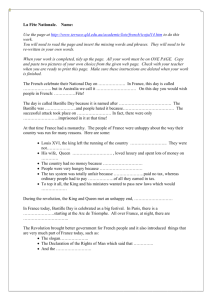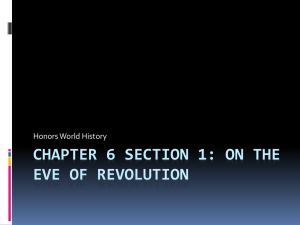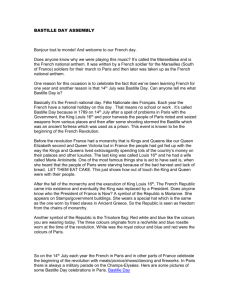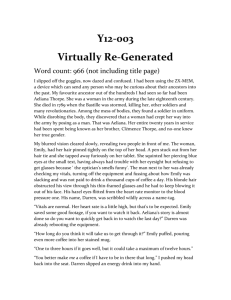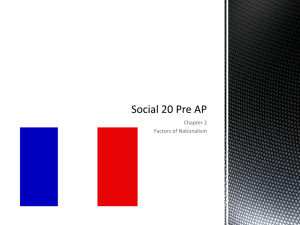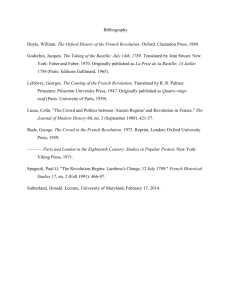Bastille Paper - Blogs @ Butler
advertisement
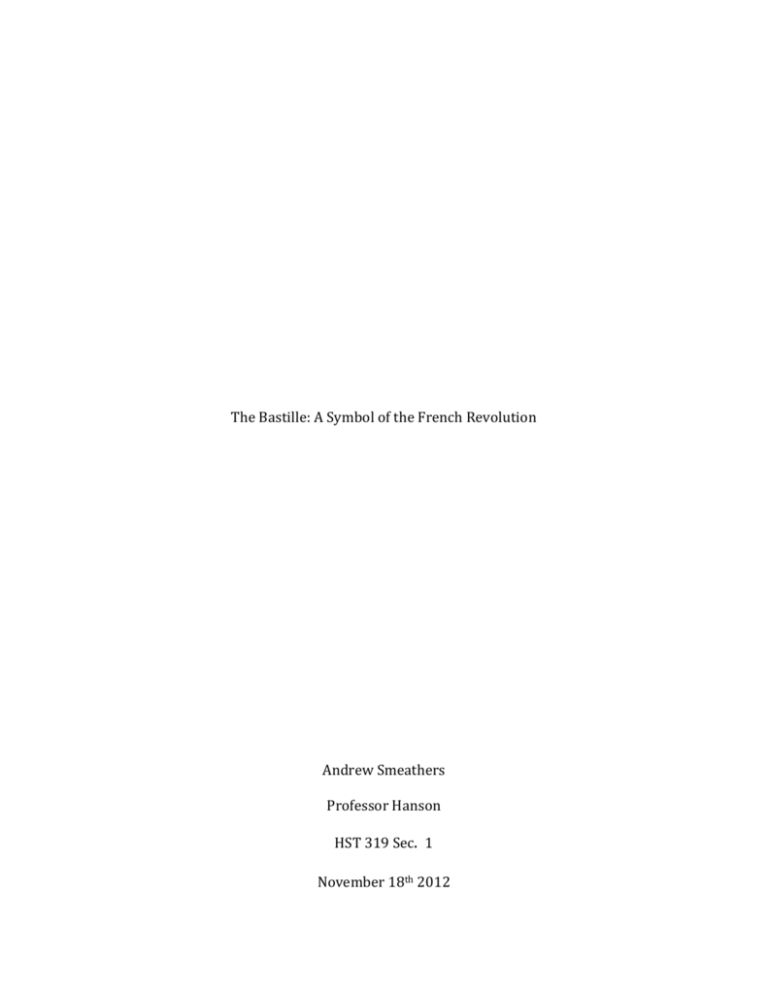
The Bastille: A Symbol of the French Revolution Andrew Smeathers Professor Hanson HST 319 Sec. 1 November 18th 2012 On the 14th of July 1789, the French citizens overthrew the guards and leaders of the Bastille in Paris, France. This radical decision was more than an attack against the government during the French Revolution. The taking of the Bastille was a symbol that all French people could relate to and rally behind. “Originally, Bastilles was nothing more than a technical term for the municipal peel towers of the late Middle Ages.”1 The Bastille in Paris, France was built between 1356 and 1382. During King Louis XI’s reign in 1461-1483 the Bastille was refashioned from a fortress protecting Paris into a state prison. In the late 1780’s the bastille was made up of eight towers that surrounded two courtyards and the city’s armory. The Bastille was used as an area to hold prisoners in the city. The governor of the prison was given a daily allowance per prisoner depending on their social standings. People who were sent to the prison were in for charges ranging from political crimes, conspiracy or stealing. Some of the prominent convicts to spend time in the prison were the notorious swindler Jean Henri Latude, the alchemist Count Cagliostro, diplomat and general Charles-François Dumouriez and wallpaper manufacturer Jean-Baptiste Réveillon, who was arrested for his own protection after riots in the Faubourg St. Antoine in 1789. 2 Over all, more than five Quote from the book: The Bastille: a history of a symbol of despotism and freedom page 6 2 The website http://www. discoverfrance. net/France/Paris/MonumentsParis/Bastille. shtml includes information about famous prisoners who spent time in the Bastille 1 thousand prisoners had passed through its walls between 1659 and 1789. But, the Bastille was more than a place for weapons and prisoners: there was a sense of despotism about the building before the ultimate fall of it. The people responsible for the taking of the Bastille are praised with fame and awarded the title, “Vaniqueur de la bastille,” which translates to, the men who took the bastille. 3 The importance of the Bastille was due largely to its functions and perception among the public. The people of France perceived the Bastille to be more than just an armory and prison. The thought of the Bastille as a symbol of despotism was alive in many of the French peoples minds before the ultimate fall of the bastille. When thinking about the Bastille, French people looked at it as a symbol of oppression of liberty and censorship, royal tyranny and torture. “Its crenelated towers in the very center of Paris summed like a dark shadow of feudalism; the lettres de cachet, its mysterious imprisonments, added to its sinister repute.”4 This thought was due to the fact that people could be sent to the Bastille for jailing with no trial at all. Writers before and during the Revolution used the presence of the Bastille as a, “physical embodiment of what they believed was wrong with the government.”5 Shortly before the taking of the Bastille it had become a pivotal symbol for politics and social interactions in France. When the Bastille fell to the The term Vaniqueur de la Bastille was first introduced in Maurois’ book– page 221 Quote from the book Miracle of France - page 238 5 Used the websitehttp://europeanhistory. about. com/od/thefrenchrevolution /a/The-Bastille. htm to better understand the meaning behind the symbol that was the bastille 3 4 people there was a change of the symbol from oppression and despotism to freedom and celebration. “The unprecedented event of the conquest and destruction of the notorious state prison on 14 July 1789 was a highly symbolic act.”6 This idea of the taking of the Bastille in a symbolic sense is much different than what it originally looked to be during the 18th century. In Lüsebrink’s book he gives four unique ideas as to why the taking of the Bastille is an important symbolic of the French Revolution. The first idea is the motivation behind the event. “The symbolic meaning of the Bastille is based not on arbitrary linguistic convention but – from the perspective of the individual speaker- on common features of historical function of the Bastille and the situation the name is applied to.” Second is the idea of ambiguity of the event. The Bastille has many different symbols including prisoners, abuse, and a despotic reign of injustice. Yet, it also stands for the freedom and revolutionary struggle that so many French people went through. The taking of the Bastille also has an associative extension since it simultaneously evokes deeper meanings of both despotism and freedom. Lastly the Bastille has an emotional appeal, “as a political symbol that is shared in its meaning and evaluation by various groups in society, the Bastille provoked and still provokes collective emotional responses that motivate, direct, 6 Quote from Lüsebrink’s book page 38 and influence sociopolitical action.”7In order to understand the many symbols of the Bastille it is important to understand the reason for the taking of the Bastille. Many of the short-term reasons for the citizens taking over the Bastille centered on the tense political atmosphere during the first days of July 1789. It started with the meeting of the Estates General in Versailles discussing how to escape the financial crisis that France was in. Immediately the Third Estate, who represented the middle class and ninety five percent of the French population, disagreed with the political preconditions that governed the assembly as well as the change in voting ways. In addition, the Third Estate at the Estates general the firing of the popular Prime Minister Necker upset the people of France greatly. The public was overwhelmed with, “political news, rumors and collective anxieties [which] led to demonstrations, panicky reactions, and acts of violence.”8 These demonstrations included a bloody march to the garden of the Tuileries, as well as the storming of the La Force and Conciergerie prisons where the citizens liberated the prisoners. These acts of violence and public demonstrations led to the creation of the Provisional City Government. This organization would have the ability to detain any citizen without reason and convict them without trial. Essentially, this would lead to the illegal 7 8 Both quotes and ideas are from Lüsebrink’s book pages 4-5 Quote and ideas from lüsebrink’s book page 40 deposition of the government. “The people of Paris feared a coup d’état and the town bristled with rumors: ‘The troops are going to butcher the patriots!’”9 These fears and actions were to lead to one of the most symbolic events in the entire French Revolution. On July 12th Camille Desmoulins, who was looked at as a young rascal of genius, cried out to the citizens of Paris “To arms!”10 A symbolic green cockade became part of the mob that was assembling in Paris. As crowds began to grow throughout the streets, gunsmith shops as well as arsenals were being pillaged. On July 14th a large group of people stormed the Hôtel des Invalides claiming close to 30,000 muskets and five cannons. However, the citizens were unable to find the gunpowder, which had been taken to the Bastille. Thus the Bastille became the objective for the large mob. As André Maurois states in his book, The Miracle of France, “The taking of the bastille is one of those events about which it is not easy or even fair to write objectively; if you limit yourself to describing the bare action the heroic attack is nothing more than a bloody riot. If we understand the part played by this even in French history, we must consider, less what the Bastille really was than what it was symbolically.”11 Rumors of an attack on the Bastille had spread throughout the city and on July 7th Marquis de Launay, the governor of the Bastille, was sent thirty-two Swiss Quote from Maurois book page 237 Quote from Maurois book page 238; also followed same ideas and concepts from both Carlyle’s book and Godechot’s book 11 Quote from Maurois page 238 this main idea was in all of the books in the bibliography 9 10 soldiers to aid in preparation for small mobs attacking the fortress. On the day of the attack, July 14th 1789 there were merely seven inmates left in the Bastille. A large group of around 300 guards had left their posts in fear of rumors of a siege attempt on the Bastille. A huge crowed armed with guns walked into the Bastille demanding guns, powder and bullets from the Governor Marquis de Launay. Peaceful negotiations did not work and what transpired was a bloody battle that led to the fall of the Bastille. Around ten o’clock on July 14th 1789 a group of delegates from the mob entered into the Bastille to talk with De Launay. The purpose of marching on the Bastille was solely to secure arms and munitions. While the discussions with De Luanay were taking place the crowd outside the Bastille began to grow in size and restlessness. After quite some time of negotiation the militia began to think that the delegates were being held as hostages. Panic took over the crowd with rumors spreading throughout Paris like wildfire. 12 When one of the delegates left the Bastille the crowed poured into the Outer Court of the Bastille. This was the beginning of the siege De Launay pulled up the drawbridge and gave fire on the crowd. The militia responded to this as if they were dragged into a trap. The fighting intensified and the crowd ignored the deputy’s pleas of a ceasefire. “On, then, all Frenchman, that Ideas from Godechot’s book page 218 as well as similar events written in the other books 12 have hearts in your bodies! Roar with all your throats, of cartilage and metal, ye Sons of Liberty; stir spasmodically whatsoever of utmost faculty is in you, soul, body, or spirit; for it is the hour!”13 As the battle ensued groups of mutinous guards françaises and other deserters from the Bastilles troops joined sides with the citizens. With the possibility of mutual massacre Governor De Launay ordered a ceasefire. He continued to open the gates to the inner courtyard where the vainqueurs swept in to liberate the fortress. The militia took the guards and De Launay prisoners and obtained what they had set out to do. They had gotten the ammunitions and gunpowder, released the few prisoners still incarcerated, and gained control of the iconic Bastille. The deaths suffered from the attack loomed heavily on the attackers side. There were a total of ninety-eight citizens killed during the battle. While only one of the defenders was killed during the fight, more were to be massacred during the evening. De Launay was injured during the fighting, and the crowd took him to the Hôtel de Ville where his fate was to be discussed. While en route, the crowd attempted to take him to the hotel, De Launay flung his arms to the sky and cried out, “Let me die!” He then proceeded to kick a vainqueur in the groin. The man, as well as the crowd, called for his death and began to stab, kick, and ultimately shoot De Launay till he was dead. The man who was kicked was given the pleasure of 13 Quote from a Vaniqueur de la Bastille in Carlyle’s book page 151 beheading De Launay. The crowd then showed off this killing and the murder of three officers and three pensioners by sticking their heads on a bayonets and parading them around Paris. 14 What followed this display of death and power by the citizens was the destruction of the Bastille. The Bastille was looked at as a symbol of despotism and fear among the French people. On July 16th the Permanent Committee, at the Hôtel de Ville, decided that the Bastille should be demolished without delay. The man who was put in charge of the task of demolishing this large structure was a man named Pierre-François Palloy. He signed on more than a thousand workmen to help with this project. Many of the men he signed were unemployed. Thus, the demolition of the Bastille was actually a good way to help relieve the economic crisis that was sweeping over the country. On February 6th 1790 the last stone of the Bastille was presented to the National Assembly. The structure that was once seen as a tyranny to society was no longer visible in the streets of Paris. On June 19th 1790, the National Assembly passed a decree giving the men who conquered the Bastille personal coats and a complete set of weapons at the public’s expense. These men were honored as Conquerors of the Bastille, showing just how much this event meant to the people of France. The taking of the Bastille was the first symbol that the people of France could stand behind. Once the bastille was destroyed there were many more symbols that 14 Godechot pages 227- 246 would come into view, to start with, this successful siege showed the people of France how powerful they could be if they stood as one and demanded what they wanted. 15 “The storming of the Bastille, represented as the victory of a nation fighting for freedom against despotism, had such an overwhelming importance for contemporaries that throughout the country it let even ordinary people forget the daily grind, and found expression in local arts and crafts.”16 One of the immediate physical symbols that came out of this event was the creation of carved stones and medals created from the rubble left over after the Bastille was destroyed. It was more than just little trinkets and medals that showed the importance of this event. The people of France looked at the taking of the Bastille as a redefined symbol of freedom. This sense of freedom transpired into what is now known as Bastille Day in France. The fall of the Bastille gave people hope during the Revolution, and still to this day the history of the event gives hope and pride to the whole country. The Bastille gave a base for the symbolic foundation of a national identity in France. From the fall of the Bastille came festivals, speeches, and monuments that commemorated the historic event. “One of the most popular pamphlets concerning the storming of the Bastille, the biography of a fictional Bastille prisoner Count de Lorges, ends – in a manner typical of its genre – with an emotional appeal by the 15 16 Godechot 260-265 Quote from Lüsebrink page 79 author asking French citizens to make 14 July a day of commemoration forever.”17 While there were many official processions and patriotic events some demonstrations were spontaneous ones. These spontaneous, “commemorations of the storming of the Bastille that took place at the initiative of individual citizens in the summer and fall of 1789 and throughout 1790,” sparked from religious debates and speeches from various people in France.18 The French people continue to show love for their country by participating in public events involving the fall of the Bastille. To a person studying the events that transpired on July 14th 1789 it is important to look at this event as a series of symbols. To say that the capturing of the Bastille was to free prisoners or obtain munitions is only part of the story. Yes, those facts play an important role in how the day happened, but the important part is how the citizens reacted to these events. The fall of the Bastille, which is often associated with despotism and tyranny, lifted the spirits of a country divided by many different problems. The French people were now able to come together as one knowing the power they were capable of having if they were united as one. Even after over 200 years since the event took place, the French people still celebrate and rejoice at what their ancestors were able to achieve. Without a doubt this passion will continue for many years to come. 17 18 Quote and ideas from Lüsebrink page 147 Lüsebrink quote and ideas page 149 Bibliography Carlyle, Thomas. The French Revolution; a History, New York: Modern Library, 1934. Print. Godechot, Jacques Léon. The Taking of the Bastille, July 14th, 1789. New York: Scribner, 1970. Print. Lüsebrink, Hans-Jürgen, and Rolf Reichardt. The Bastille: A History of a Symbol of Despotism and Freedom. Durham: Duke UP, 1997. Print. Maurois, André, and Harry Lorin Binsse. The Miracle of France; New York: Harper, 1948. Print. “Place De La Bastille, Paris.” Place De La Bastille, Paris. N. p. , n. d. Web. 08 Nov. 2012. <http://www. discoverfrance. net/France/Paris/MonumentsParis/Bastille. shtml>. Wilde, Robert. “The Bastille.” About. com European History. N. p. , n. d. Web. 08 Nov. 2012. <http://europeanhistory. about. com/od/thefrenchrevolution/a/The-Bastille. htm>.
